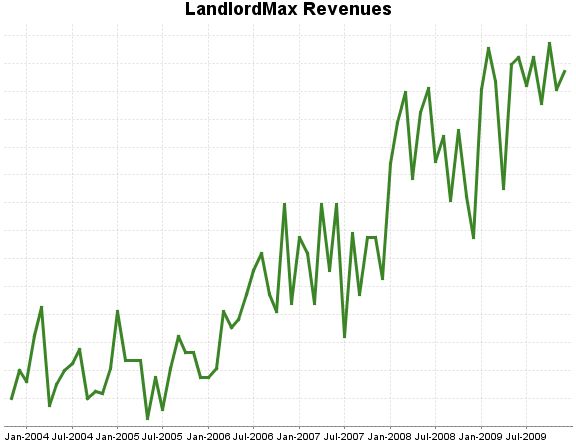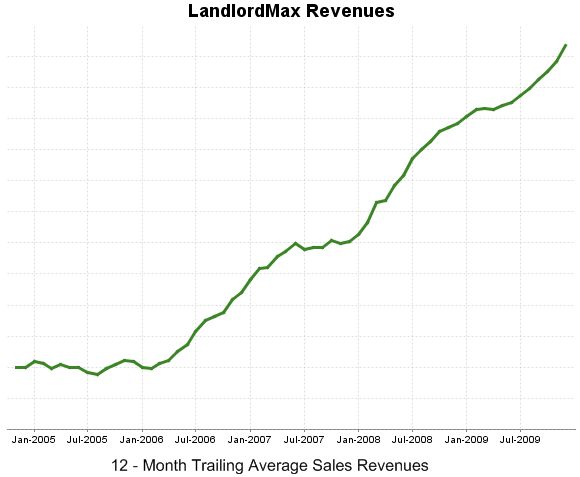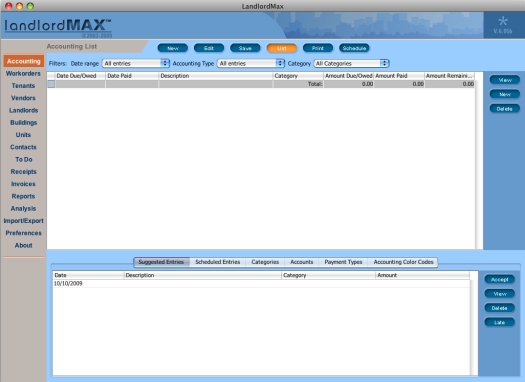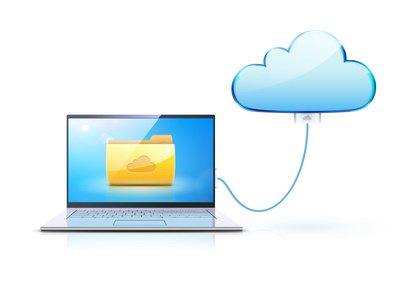What are the Risks of Cloud Services?
Through my company LandlordMax I hear lots of people asking if we have a cloud offering (in case you’re wondering, we don’t yet). The thing is that most people ONLY look at the benefits, very few look at the potential and catastrophic issues that you’re at risk of. For LandlordMax we use several online (cloud’ish) solutions, and it’s great for many things. The problem is that you also have to be careful because for some things the downside can be catastrophic! Even possibly terminal to your business! It can be much bigger than you realize and I’ll explain why in just a bit.
First, let’s make sure we’re on the same page about what cloud offerings really are. So what exactly is a cloud offering? Most people today have come to define a cloud service as a service that’s hosted online. Although not exactly right, it’s pretty close. And for the purpose of this post we’re going to define cloud services as all online services. In most cases these are just going to be websites that offer services. Again, although not technically correct, it’s close enough for today. And anyways this is what most people understand cloud services to be.
If you’re interested in the exact details, Wikipedia has a nice article about cloud computing. As well you’ll probably want to check out their article about SaaS (Software as a Service), which is actually closer to what people really mean when they say cloud services.
In any case, let’s start with the benefits, so we can understand why people are so interested in these solutions (including myself):
Benefits:
- Affordable: You don’t have to invest in any infrastructure, computers, etc., it’s all taken care of for you and amortized over time.
- Automation and Maintenance: You don’t have to manage any computers, servers, upgrades, etc. It’s all taken care of for you.
- Mobility: You can generally access the service anywhere there is an internet connection.
- Focus on core competencies: Instead of spending time setting up your infrastructure, computers, etc. you now have the time to spend on where your real value is.
- Scalability: Most online solutions will offer a significant amount of growth. You just move up plans. Amazon’s EC2 service recently had an amazing example where a system scaled up to 50,000 CPU cores within 3 hours.
- Easier: If you don’t have to set up anything. You don’t have to figure out how it works. It’s all done for you.
- Vendors are more experienced: In most cases, the service you’re using is the vendors bread and butter, they work in these systems all day, so they know their stuff in and out whereas for you it’s just to get the job done.
- Quicker: You can generally sign up and start using the solution within minutes. If you have to set it up, it can take days, weeks, or more.
- Less commitment: Maybe you only need the service for a month, half a year, etc., which means you can save from having to invest in a ton of infrastructure for a short lifespan.
As you can see, all of these are great benefits. Who wouldn’t want them? Especially for a smaller company, the benefits are incredible.
Of course, like everything else in life, you can’t have everything. Cloud services do come with costs. Not so much in terms of dollar costs, but in terms of very huge potential UNSEEN RISKS. This is especially true if you have to store data!
There are a few other cons, such as you can’t access your data without an internet connection, and so on. But really there’s really just one very big con, and unfortunately it’s generally unseen until it happens. That’s the worse kind of con! What’s worse is that most people don’t really talk about them, mostly because cloud services are still fairly new enough that most people haven’t really had a chance to experience this very big and potentially catastrophic con.
But before I explain it, let me give you an analogy that’s probably closer to home, and that you’re likely to have already encountered.
Most people store their pictures on their personal computer hardrives. Hardrives do fail. Google published a groundbreaking research report and the results were quite troubling. Basically you can expect drives to fail at a pretty predictable rate. And unfortunately it’s not just hardware failures that you have to deal with, all kinds of things can happen such as a virus corrupting your system, power surges, and so on.
In any case, before there were digital cameras, most people really didn’t have that much data, so all their really important data could usually be backed up on a CD or DVD (or if you’re old enough to remember this, floppy disks or tapes). It sucked to lose your saved video game files, or to have to install your applications again, but you usually could. Sure you’d lose some data, but usually it wasn’t that critical. Most important was generally backed up on floppies, CD’s, etc. because it was quick and simple.
Nowadays with everyone having a digital camera, there’s lots and lots and lots and lots and lots of pictures saved on people’s computers. Pictures they really don’t want to lose. The data is now much larger and generally more valuable. There’s so much data these days that in many cases you can no longer just back it up on a CD or DVD. But even at that, because of the quantity of data, most people just simply don’t do any backups at all, they expect their computers will just continue working. And computers usually just work until one fine day where it eventually fails and everything is lost. It’s terrible and catastrophic. Years of pictures lost in an instance!! It’s devastating. Yes there’s other data, but for a lot of people, their pictures are their most important data.
And so as cameras have become more common, we’ve started to experience more the pain of computer failures. And as such, it’s now much more common for the average person to have an external hardrive to backup their data. 5 years ago almost no one did this. Although not everyone still does this, it’s much more common. And its definitely going to be that much more common with time. We’re learning from our experiences. Once you experience it you vow never to let it happen again. It always takes that first time to wake people up, myself included.
I’ve been backing up prolifically since as long as I can remember because I’m one of the lucky ones to have experienced my first computer failures eons ago. And in 2006 I even wrote a post called 4 Simple Steps to Protect Your Data From 99.9999% of all Computer Failures which is still as true today as it was back then. I still mostly adhere to these steps, with the exception that I do even more today than I did back then
So why did I go on such a tangent with digital cameras and data backups, because when you use a cloud service to manage your data you’re basically exposing yourself to exact same risks!! You might not realize it, but with most online services you’re basically running without a net. There’s no backups. If anything happens, it’s the same as a computer failure with your digital pictures. And if the data is critical to your business, it could be catastrophic. What’s worse of all, there’s often no warning at all before it happens.
So let’s get into this con in much detail.
Cons:
For the cloud services you use right now, do you have a backup that you can use if they close down or you decide you want to move elsewhere? In most cases you have no way to extract your data at all, nevermind moving to another service. In those situations that you do, can you actually take that data file and use it anywhere else? Maybe in theory yes, but can you really in practice? If you can’t, then you might as well not have any backups at all. Why fool yourself into feeling more secure when you really aren’t. And this question leads us to some very interesting and provocative questions.
What happens if the company closes or decides to no longer offer their cloud service? All I can really say is good luck with that! Imagine for a moment that you have a contact management system and you have tens of thousands of contacts stored, with all their interactions, etc. The company that hosts the cloud services suddenly closes. What happens the day after the company closes? If it’s a service, the service is shutdown immediately. You’ve just lost all access to the system and your data overnight. Ouch!!
Online services that manage and store data have a lot of additional and very high risks. The scenario I just described is the same as if your hardrive just crashed and you just lost all your pictures and documents without any backups. However in this case, maybe your business relies on the data and system. It sucks to lose your pictures, but you can and will survive. Can your business survive? What is the impact on your business?
If it’s just a backup service of your data files, then it’s not a big deal, you can just re-create the backups with another service. Sure in the meantime you have no backups, but it’s quickly resolved. However if it’s all your customer and vendor contact information, communication histories, contract negotiations, etc., then the impact is going to be huge. What if you were using an online property management software system to manage hundreds or thousands of units and tenants and suddenly you have no access to anything. The impact could be severe enough to cause you to go bankrupt (you may not be able to properly collect your rents on time to pay all your bills, or even know what all your bills are)! That’s a huge risk. A risk that’s so large that it overshadows all the possible benefits!!
Which leads me to my next question, how much warning do you think you’ll get if the company hosting the cloud service closes? I can’t imagine a company that’s managing contacts, emails, projects, etc. publicizing that they’re on the brink of closing. Most likely you’ll have absolutely no warning. One day everything will be fine and the next day the system is down never to come back up. And to be quite honest, I don’t know that there’s much you can do to prepare for this anyways, even if they gave you a warning. How are you going to extract your data? What are you going to do with that data?
Following this, what happens if the service you’re using significantly changes it’s pricing model? It’s not uncommon for an online service to adjust their prices, there are many stories of significant increases in prices. Especially for newer companies, which most cloud based services are. Or better yet, what happens if the company gets acquired? Will the pricing models change? Other than paying what they want to charge you, what option do you have? Sure you can move, but can you really? What is the cost of transitioning?
And what will happen to the could service when it gets brought into the new company as part of an acquisition? Will it stagnate? For example Mint was acquired by Intuit in 2009 and a year later the comments weren’t that great. What if the new company is a competitor? Will they force you to transition to their service or you lose all your data? One of our big competitors has been doing this with the competitors they acquire. They’re basically closing the solutions they acquired and are forcing everyone to move to their cloud based solution. Not everyone is happy about this. It’s yet another very big risk of using a cloud service?
Which leads me to my next big question. Do you trust this company over the lifetime of your own company’s needs? In other words, will they offer the same quality of service in 2-5 years? What about in 10 years? If transitioning is next to impossible, which it is for most online cloud services, then you’re at their mercy. They could never upgrade or improve the service, or worse it could become slow, buggy, etc. with time. What recourse do you have other than completely starting over?
With a solution you install and manage, you don’t ever have to upgrade if you don’t want to. In fact, the company has a very strong motivation to improve their software because they generally only get paid when a new version that has enough value to upgrade is released. If it’s not good enough, people just don’t upgrade. And with time, the value of upgrades becomes more and more significant. In other words, the company’s motivations are probably much more inline with yours when they aren’t cloud based. They need to convince you spend more money on them, that the value is worth it.
Conclusion
Unlike pictures where it would really suck to lose Johnny or Susie’s 1st birthday pictures, the impact to your losing your data could be so significant as to destroy your business. I’ve already given a couple of examples, and it’s pretty easy to come up with additional ones. Basically anywhere you store data that’s critical to your business is at high risk.
Therefore I would now recommend you look at what services you use and determine what the costs would be if they suddenly went down tomorrow. Is that cost worth the benefits? In some cases yes, absolutely, but in other cases no way would you ever even consider it if you had thought about it first.
The thing is that today most online services are still fairly new, and most really haven’t had the chance to close. Although cloud computing isn’t new, it’s really only been in the public’s attention for a short time. And as such very few people have experienced the downside. If I was to guess, I would suspect that most like you haven’t either.
I’ve personally only experienced it once, and it wasn’t with one of our core products, but even then it was pretty painful. I learned my lesson. Never again. And thankfully it wasn’t a service that’s core to my business. And because of that I’ve since been very careful with what online services my company uses.
Anything that can severely cripple us has to be done internally. It has to be installed and managed internally. This doesn’t protect us 100%, but what it does offer us is a buffer. If something happens we have some time if the company closes, collapses, changes, etc. We can at least still continue to use their software until we find an alternative solution, even they don’t exist anymore. We can’t use them indefinitely, but we do have some time to transition to another system. We might not be able to transition the data, but at least we can continue to access the old system if need be. And because we have some time, we can always hire someone to help us in moving data from one system to the other, even if it’s manual data entry. The key is that we at least have options. And most importantly that we’re not without our system overnight.
And with that, I will say that my company probably uses close to a dozen online cloud services. Am I a hypocrite? Am I willing to take those risks? Absolutely not. Each service we use would not cripple us if they closed tomorrow. It wouldn’t be fun if they went down, but it definitely wouldn’t be catastrophic either. There’s only one online service we use which I’m planning to push to an internally manage solution sometime this summer. It also wouldn’t be a catastrophic loss, but it would definitely be more painful than the others. It’s the only solution left with data that we’d need to extract that we wouldn’t be able to. However if we lost the data, it wouldn’t be catastrophic. It wouldn’t be pleasant either, but we could manage without too big a hiccup.
To give you an example of solutions we manage outside, internally we communicate using HipChat. Well at least until last month, before that we were using Campfire. Obviously we were able to transition because we’ve already done it. Losing either of these services overnight wouldn’t be fun, but neither would really slow us down much. They’re very useful and do increase our productivity internally, and losing the chat histories would have some costs because some info would have to be re-communicated, but as I’m sure you can appreciate, the exposure is pretty minimal compared to the costs and risks.
Another example is that we use Aweber to manage our company newsletter. Before I begin, let me just start by saying I chose them because of their reputation and my belief that they aren’t going anywhere anytime soon. In any case, if something happens, yes we’ll lose the latest email subscribers since our last local backup. That’s a cost, but really it’s not that big a deal. Yes we’ll lose our stats over time. They were nice, but we can live without them. The biggest pain would be importing the mailing list with a new service. Most likely all our subscribers would be emailed to confirm and verify they want to be subscribed to the new service managing the newsletter. So as part of this effort, we’ll probably lose a percentage of our subscribers. It’s not pleasant, but by no means is this catastrophic. We can definitely recover.
If however I was a real estate investor, or a property management company managing properties for others, losing all my data could be extremely catastrophic. All of sudden I no longer know which tenants owe me what amount of money (rents, back rents, damages, late fees, etc.). I now have to find all the signed lease agreements and go through that manually just to calculate this month’s rent roll. If I have 300-500 tenants, I might not be able to process all that information in time (I might have 5000 tenants on file but only 500 are currently active). What about all the workorders I have on file, all that information goes away. In some cases a request to fix a leaky sink can just be re-requested by the tenant, but what if a workorder is critical and it gets lost (for example a vacant unit needs a roof repair otherwise it will collapse, a leak that goes unchecked escalates, etc.). If I’m a property management company, I might have obligations on when I need to pay the property owners their rental revenues so they can meet their mortgage obligations, but if all my information is gone, I might not have the time to manually process everything. And when I do find a new system, in this example I now have to enter 500 units worth of data, 500 tenants contact info, 500 leases, etc. How long will that take? I might not be able to survive the 1-3 months it takes me to recover from my online cloud service disappearing on me overnight.
Using an online solution in the above example could be very catastrophic. In this case the risks just aren’t worth the benefits. In this case you’d most likely want to acquire a system which you can manage internally, so that if the software company closes, decides to stop selling the software, gets acquired, changes prices, etc., you can still continue using their software until you find a proper replacement. Otherwise you could come in to the office one day to find yourself in a world of hurt.
Online and cloud services can be very beneficial. They definitely have their merits. We use many such cloud services here within LandlordMax. However you always have to be vigilant in terms of what and how you use them. They really only have one con, bit it’s a whopper of a con! Which is that your data is at their mercy. You generally don’t have backups or anyway of transferring it. So always, and I mean always, make sure that a permanent disruption of the cloud service you’re looking to use isn’t going to destroy you. And if you’re already using it, then you should already start to make preparation plans just in case the worse does happen. Don’t wait until it’s too late because by then it will be too late!
Permalink to this article Discussions (6)
LandlordMax 2010 Best Fiscal Year Yet!
As many of you have probably noticed, I haven’t posting nearly as often as I used to on my blog this year. The reason is that I’ve just been way too busy with my company LandlordMax, and with good reason. We just closed up our last fiscal year with an increase in revenue of about 40% over the previous fiscal year! Not only that, but in regards to our calendar year, we’ve already beaten our complete revenues for last year, and it’s still just the summer. Which means that our next fiscal year will be even better. Right now we’re looking at a 100% growth in revenues over last year assuming no further growth for the remainder of the year.
What’s really cool is that this is all happening in a recession, with the real estate market being one of the worse markets. In the last few years alone 3 of our very big competitors have closed up shop. Well one was discontinued because (and this is a quote from their website before it was taken down): “it is not the quality of product we think it should be”. But nonetheless 3 very big competitors have completely disappeared from the market. There’s a shakeout happening right now.
So I’m pretty excited about our prospects for this upcoming fiscal and calendar year. Not only are we very close to releasing a multi-user version which should significantly and positively impact on revenues, but it’s also looking like we’re going to break our monthly sales record again this month.
Although these are tougher economic times, hopefully the success of my company can be a shining beacon of success and light to help motivate you too. I know that it helps me to see what others are achieving. It’s not all gloom and doom out there, there are definitely pockets of light and success.
On another note, because of all the above, it’s going to keep being insane for me until at least Xmas. And with that in mind, I hope you can understand and appreciate that as much as I’d like to write blog posts on a weekly basis like I use to, I’m going to have to fall to a less time intensive schedule. My new goal is going to be once a month because there’s just no way I can achieve once a week right now. My blog posts take me a minimum of several hours, some as much as a several days. I just don’t have that luxury right now. But I am looking forward to coming back in force in the new year. And although I won’t post as frequently, rest assured the quality of each post will continue to be as high as ever.
Permalink to this article Discussions (2)
Out With the Old, In With the New!
You would think that as summer is just starting things would be slowing down as they usually do around the summer months for us, but this June and July have probably been the busiest months for me in years! Above working very hard on the networked version of LandlordMax, we just released a major website upgrade of LandlordMax a few weeks ago. This was the culmination of many months of hard work, and I’m happy to say it’s a huge success.
Of course as with all new releases, there’s always a lot of follow-up work involved. Some features we wanted to release as part of the website had been postponed so that we could release earlier. Now please do pay careful attention here, the website wasn’t released before it was ready, it wasn’t all buggy and nothing worked (we did have some minor bugs like all new major releases), but rather we omitted some nice to have features which we released shortly thereafter and are still continuing to release today. We’ve almost had a silent website every day since we initially released. That’s the benefit of automating your releases!
Right now our biggest push is to improve the videos. Although very accurate in their information, some are a bit dated. Not only that but the sizes of the videos aren’t as consistent as we’d like (some are smaller and others larger). So we’re working very hard right now to clean all that up. That and we’re going to add many new videos over the next few weeks and months.
Another major enhancement is that the videos will no longer be popups. We’ve been discovering that too many people either turn off popups or quick disable popups when asked by any website. Once this action is done, or the feature is disabled, the videos no longer work for these people. And unfortunately enough people don’t fully appreciate what the issue is and therefore we’ve decided to adjust the website so that it works for everyone. These changes are coming very soon!
There’s a few other enhancements we’re working on, but overall we’re very happy with the new website. And best of all, we’re already seeing very positive and measurable results! It’s the best I could’ve asked for. And I’d also like to take a second to show my appreciation to Reuben for all the extra efforts he did in helping us realize the website. Thank you Reuben for all your hard work!!
Permalink to this article Discussions (3)
LandlordMax Now has a Facebook Fan Page
As part of being more online, above having this personal blog, and having a personal Twitter account which I should tweet more frequently, I’ve also just created a Facebook Fan Page for my company LandlordMax.
My plan is to post more frequent updates on the LandlordMax Facebook Fan Page than I do here. Unlike a blog post which can take many hours to write and publish, a status update is much quicker and easier. I can write them in just a few seconds/minutes, hence why I plan to post more frequently.
The other added benefit is that people can post back, making it more of a direct discussion instead of me mainly publishing articles and people commenting on them as I do here. That and it’s easier to follow the discussions than on Twitter.
Therefore if you want the latest information on LandlordMax and don’t want to wait for me to write full blog posts, please do join us and become a Fan of LandlordMax on Facebook right now. I look forward to hearing from you!
Permalink to this article Discussions (0)
Should Software Companies Charge for Technical Support?
I personally believe that technical support for most software should be free, especially if it’s the result of poor software, of buggy software, or even just badly designed software. There are a few exceptions of course, but overall I don’t believe software companies should charge for technical support. To be quite frank, in a lot of cases it’s a conflict of interest, plain and simple. Especially if the the technical support is a profit stream for the company!
Let me give you an example. I’m going to compare my company LandlordMax which sells property management software (also known as real estate rental property software). Most of my competitors (without naming names) charge hourly for technical support (upwards of $200/hour). My company absolutely does NOT charge for any technical support. So why do most of my competitors do? Because this is a big source of revenues and profits for them.
To be quite frank, none charge a an understandable amount like $20-$50 an incident, where the goal is really just to recover the costs of offering the support. Rather most of my competitors will charge per the hour or require a minimum yearly support contract. The worse one I know of requires a minimum support contract can be up to 75% of the purchase price – in other words, you almost pay double the listed price for the software in support, and it’s required (you cannot purchase the software without the support contract). I don’t know why it’s like that in my industry, or how it got that way, but it seems to be pretty common. And I absolutely don’t agree with it!
So why is this bad in the first place? Why is this a conflict of interest? Well if charging for technical support is a profit stream for them, wouldn’t resolving ongoing issues, improving the usability of the software, fixing bugs, etc. be against their best interest. Sure they have to achieve a minimal level of sales, but after a certain point it can quickly become much more profitable to charge people to help them use your software than to acquire new customers. Especially if their data is locked in. You see in my industry, changing software solutions often means either re-entering all your data or starting from a clean slate, which is not what you want for managing real estate (your history is very important).
It’s so rampant in the real estate rental software industry (charging for support) that many companies have gone so far as to also charge significant amounts for training. Now I can appreciate that for some software solutions you will require training, but I can’t see how managing properties is one of them. At least not for all classes of your customers. I can see why some assistance may be required for a networked office with a team of people using it. But a small property management company or an individual real estate investor probably shouldn’t require extensive training. But that’s just my opinion. After all, what do I know about the industry, I just run one of the top property management software companies.
Without naming names again, I can tell you that for one solution I tested I couldn’t even figure out how to create a building and tenant to setup them up with a rent. I had to revert to reading the user manual, and even then it wasn’t perfectly clear, I had to fiddle around a bit. And this was a bigger player at the time (some years ago). Incidentally, they’re pretty much on their way out now.
But it’s not just support and training, what about documentation? Something to remember is that writing documentation such as a user manual, online help, FAQ’s, etc. does cost money. I’ll be the first to attest that our online documentation isn’t perfect, and we’re definitely working to improve it. Nonetheless, it’s better than most of our competitors right now.
And to be quite honest, as a company you provide documentation for several reasons, not all of them altruistic. Firstly to help your customers learn your software. Secondly to help them discover things it can do that they weren’t aware of. But you also leverage your documenation to reduce your support costs. That is to say, that for every person that can find the solution on their own on your website, that’s one less support request you have to handle. That’s one less support request you have to pay for. So it’s to your advantage to improve your documentation.
Now if you charge for technical support, where you not only just make your costs back, but where you actively make a nice profit, where is the motivation to improve the usability of your product? Where is your motivation to improve your documentation? It’s partially there, so much as you can get sales. But to truly maximize your profits you would probably want to make your documentation just good enough to get the sale but not good enough for the customer to figure things out on their own later so that they have to pay for support. That would be the optimal setting in such a setup.
Everything said, please bear in mind that I’m not advocating that all companies who charge for support are out to make money from you. In most cases they aren’t. What I’m against is companies that make bigger profits from charging for technical support. As soon as you turn your technical support into a profit stream, you’re basically setting yourself up for a conflict of interest. It’s unfortunate, but that’s just the way it is.
Like a proud parent (and as a disclaimer), I also have to take a second to brag about my company LandlordMax. So if you’re not interested in our metrics please do skip to the last paragraph. With a lot of hard work, we’ve been able to almost eliminate our support costs for existing customers. What this means is that almost all our support requests are pre-sales. Questions asking if the software can do this or that, which in most cases the answer turns out to be yes.
Generally once someone has purchased LandlordMax, they don’t contact us for further support, they’re completely self-sufficient. I’d say that 90+% of our support requests from existing customers can be categorized into two groups. They’ve either bought a new computer and want to transfer their data from one computer to the other, or they’ve lost their license information and need us to re-send it. Rarely do we get support requests otherwise. It’s all pre-sales, people asking for more information on what the software is capable of. Which tells me where we need to improve the most (yes, the website – which by the way we’re on the verge of releasing a major website update in response to this).
And just in case you’re wondering which types of solutions I would recommend charging a minimal cost for, to at least cover your own expenses of running support, would be software offerings such as an operating systems (you can’t control the crazy stuff people do to their computers), a system that requires a high level of technical skills (like setting up a server, a network system, a database, etc.), a system were the users can script part of the program, etc. Basically where it’s no longer self-contained. Where it could no longer be classified as shrinkwrap software.
Permalink to this article Discussions (10)
LandlordMax Customer Testimonial
It’s been quite a while since I’ve published any testimonials about LandlordMax, so today I’m going to take the chance and highlight a couple of new ones.
As I am a very small business, your software is most likely on the upper end of what I need, but it is what my accountant wants me to use and it has served my needs very successfully since the inception of the business.
– Horace White
And
I am new to Real Estate investing. Your application was recommended to me by a seasoned investor. I’ve been using it for about 4 months, and am extremely pleased with it. It gives a really clear picture of where you are with your investment. I find it very easy to use from the get go. Thanks for your efforts in that regard.
– Rudolph Griffith
As well Teo of PropertyDo.com wrote a 2-page review about LandordMax, giving it an overall 8/10 score, their second highest score for a property management software!
Some of the more interesting exerts (by the way, some of his concerns have already been addressed in the latest version – such as having bar charts, pie charts, etc. in the reports – this is a review of version 3.11 done a month before version 6.05 was released, therefore this feature wasn’t available at the time):
During our LandlordMax review, the first test that we put it through is compare it with our checklist of must-have features. The huge range of features that comes with Landlord Max far exceeded our expectations. It is quite safe to say the features of this software will be enough to satisfy the most picky of landlords.
What’s more important is that the features and details offered by LandlordMax are helpful and practical
This makes it stand out from some programs which look like a bunch of code strung together by programmers who know nothing about property management.
Despite all the functions that comes with LandlordMax, it remains surprisingly easy to use. This is possible due to the clever design of the software which puts the basic features upfront and leaves the advanced ones in the background.
What really makes LandlordMax shine is its unmatched report generator. With the click of a button, you can churn out over 100 different reports. While the creation of reports is a standard feature of most property management programs, no other software comes close to the might of LandlordMax.
Later on Teo does a comparison of different property management software solutions and here are the highlights:
If you have a slightly larger budget, then LandlordMax will be an excellent choice for you. In exchange for paying a bit more, you will be getting a big bundle of highly helpful features such as detailed reports, late fee calculators and a full blown database. These valuable functions are rarely found in low cost property management software under $300.
Despite being armed with powerful features, LandlordMax still remains highly easy to use. We really love the thoughtful design of this software that displays the basic and most common functions upfront while leaving the advanced ones in the 2nd tier. Even if you are a first time user, you will be able to use their basic features with no problems at all.
All in all, a good day for LandlordMax!
Permalink to this article Discussions (0)
2009 – A Year in Retrospect

2009 has been my busiest year to date since I’ve started blogging almost 4 and a half years ago and founded LandlordMax 6 years ago! Looking back, it’s hard to believe everything that’s happened. Which is why I’m going to take a breather today and look back at 2009, to share with you all that’s happened. Every once in a while I like to do that, and it’s been way too long since the last time.
When 2009 started, LandlordMax (the property management software company I founded) was growing at a very nice pace and the real estate market hadn’t collapsed as far as it has today. We were in the process of trying to release our biggest ugprade, version 6.05. We were also trying to get a Mac version out in the first half of the year, and hopefully get much further on the networked multi-user version. I had also just published my book Blog Blazers (November 2008) in which I had interviewed 40 top bloggers about their take on blogging. Above that I was in the process of a major redesign of this blog. Those were the major items on my plate as 2009 started.
Overall it mostly went as planned, with some surprises and exceptions. The biggest unexpected was just how much work it was going to take to make it all happen. If I had known ahead of time just how busy 2009 was going to be, I probably would’ve been a lot more stressed. Sometimes ignorance is best. In any case, here is my journey broken down into sections:
LandlordMax
Just to quickly re-iterate, LandlordMax is the company I founded about 6 years ago. The company primarily builds and sells property management software to real estate investors, property management companies, property managers, banks, colleges, and anyone else who needs to manage rental properties. The software manages the accounting, workorders, invoices, leases, tenants, buildings, and about a million other things. It’s a very useful and powerful piece of software.
When 2009 started, we were very actively working on a major upgrade of LandlordMax, which eventually was released as version 6.05 in May 2009. In it we included many new features, including a large amount of charting, email integration, Outlook support, whole new sections (accounts, contacts beyond tenants, vendors, etc.), over 20 new reports to the already more than 100 reports, and lots of other exciting new features. It was a massive undertaking that although started long before the year began, was finished before the year ended.
The only downside is that we couldn’t offer all the features we had wanted to and release it within a reasonable time. For example, we wanted to offer a feature we called “Archiving”, but as we tried to implement it, I realized it was going to be a major undertaking, taking more time than I wanted to get this version completed.
We also tried to get check printing into the software but had I to make the very hard decision to push it to a future release. After having committed a lot of time and money to check printing, it became clear that it wasn’t going to be doable within the time frame we had. So for now, this is a feature that has been put on hold. I hate to see all that effort put on hold, especially after having already invested so much effort and time, but it was the right decision. It was the hardest decision I that I had to make in 2009.
That being said, LandlordMax version 6.05 was very successfully released in May 2009. The feedback and comments we received have been amazing. Here’s just a few samples of the latest testimonials: 1, 2, 3. And those are just the ones I’ve published here on my blog, there’s many more on the LandlordMax Success Stories page.
Within days of version 6.05 being released, a big push went forward to make it available on the Mac. We’ve been working on this on and off for some time, going as far back as 2007. The problem with the Mac version is that there’s always tons of small and extremely annoying differences that need to be correctly handled. Things from how the installer works to how the program is rendered on the Mac. But this year I decided we had to make it happen no matter what. What I initially thought was going to be a certain amount of worked turned out to be a lot more than I had planned. And I mean a lot more! On the scale of 3-5 times more work!
Back in August 2009, I was already mentioning here how the Mac version was going to be coming very soon. That we only had one issue remaining. How wrong I was! A month later, in September I wrote about it again saying how wrong I was in my last post. We had resolved it, but now there were other issues.
One issue that was particularly troubling was due to the fact that LandlordMax is built on the Java platform. On the Mac, Leopard uses Java 5, and Snow Leopard uses Java 6. There is no overlap, and you can’t choose one version or the other, they each use a different version. Which means to support Leopard and Snow Leopard we needed to make LandlordMax fully Java 6 AND Java 5 compliant!! We’d been planning to upgrade to Java 6, but we were hoping to push that off until after the Mac version was released. Turns out we had to deal with it now.
At the end of October, we finally released the Mac version of LandlordMax! And it was compatible for all versions of the Mac OS, Leopard and Snow Leopard. Not only that, but you could take a backed up database file from the Windows version and move it to the Mac, and vice versa. In other words, you could use LandlordMax interchangeably on the Mac and Windows!
The Mac version of LandlordMax has since been received with lots of enthusiasm as shown in this initial testimonial, with many more to come. But in terms of estimated cost, we spent several times more than I had initially planned. And this is after having already committed lot of resources in the past.
During all this, the property management software market has dramatically changed. A company that’s been buying up many of our competitors over the last couple of years in the hopes of becoming a major player, Domin-8, has filed for chapter 11 bankruptcy. They acquired companies such as Rent Right, Spectra, Tenant Pro, iCam, Management Plus, and so on. This is big news because most companies have very limited success after filing for Chapter 11. Not only this, but we’re already starting to see people jumping ship as they’re learning the news. No one wants to be stuck with a software from a company that’s no longer around, especially with the speed of technology today. Which means 2010 may be a very interesting year for the property management software market. A shakeout year…
And as you all know by now, the real estate market has also been going through a major recession! You would expect our sales to be impacted negatively, but quite the contrary has been going on! Our revenue growth hasn’t stopped in the slightest, we’re still growing at the same fast rate as before as shown below (the graphs below only include sales of LandlordMax):


All in all, it’s been a great year for LandlordMax. Things have definitely been going in our favor. The only thing we haven’t yet succeeded in doing is releasing the networked version. A lot of work has already been done here, but the progress has been slower than I’d have liked. Not because it’s hard or a lot of work, which it is, but because I’m always having to allocate effort away from it to other more immediate items. For example, to get LandlordMax version 6.05 out on time, we had to pause the effort on the network version for several months. And for the Mac version, well let’s just say that all the effort was focused on the Mac version during those months. Like I said before, the Mac version required much more work than anticipated and I made the commitment to follow it through, even at the cost of delaying other items.
Which means that this year, we’re now working very hard on the network version. I expect there will be a new version of LandlordMax before the networked version is available, but I can’t confirm this. I also believe it won’t be until at least late in the year that the networked version will be available, if not in 2011. Above this, the website is in the process of going through a major uplift! That’s what’s going on right now. We’ll see what happens. I can’t wait to write a similar post when 2011 comes on what happened this year!
Blog Blazers
In November of 2008, I published the book Blog Blazers. In Blog Blazers, (also available on Amazon), I interviewed 40 top bloggers, (bios can be found here). The book took me a good year to publish and I’m very proud of the results. In it I asked everyone the same questions so that you the reader can compare apples to apples and oranges to oranges. Not only that, but one of my goals was to make sure the questions had a lot of follow-up material so that you could continue learning after you were done reading the book. Questions such as What was your most successful blog post ever? Which books and websites do you recommend to new bloggers? What’s your best tip for writing a successful blog post? To name just a few. I even wrote some follow up posts to help people find further resources such as 10 Most Popular Books in Blog Blazers.
Because the book was released in mid-November, it was just in time for the Xmas rush. And of course, because it’s a new book from a new company (Levac Publishing House – owned and operated by yours truly), there were some initial distribution issues. For example, Amazon will only initially order a limited number of books for new books and from new publishers. And because of this, Blog Blazers was almost immediately out of stock on Amazon. The good thing is that although it took alittle bit of time, we were able to resolve the issue quickly enough. And of course, it’s a good problem to have!
Other than that small initial glitch, Blog Blazers as a whole has been a pretty smooth ride. Most of the issues with the book were in it’s production, the marketing and sales was fairly similar to LandlordMax. Actually, I learned so much from the production side that I ended up writing a 3 part series on how to publish a book. Here is the link to the series: Part 1, Part 2, Part 3.
The biggest thing I learned about publishing books is that profits can only really be made by selling books in large volumes. You have to move at least 10,000-100,000 books to make any kind of money. Less than that and I’m at a loss how you can make any profit (assuming you have a marketing budget). The profit margins are definitely lower than I expected. To be honest, I really did learn a lot more than I ever expected about the book publishing industry. I now have a very big appreciation for the effort that goes into making a good book, and just how hard it is to produce and succeed. I now thing that books in general are under-priced. That being said, lots of copies of Blog Blazers were moved. Right now there’s just a fraction of what I initially printed left before I need to make a decision on the next print run. So that’s pretty exciting.
In regards to how the book has been received, it’s gotten a ton of glowing reviews. It’s been reviewed on major websites, blogs, magazines. It’s landed me several interviews, podcasts, radio spots, video reviews, guest appearances, etc. It’s been used used for a workshop at Drake University. What’s also very excited is that on Amazon, a site known for it’s reviews, Blog Blazers has gotten an average 4.5 star out of 5 stars! Almost no books get 5 star reviews, it’s extremely rare. Most books get anywhere from 3 to 4 stars. 4.5 stars is exceptional!
As the year has been wrapping up, I’ve had to decrease my marketing efforts. Right now the book is mainly selling itself through word of mouth. I might put another big marketing push or two, but I don’t expect to put as big a marketing push as I did in 2009. It’s a lot of work and because of that I believe it took a lot of my time away from LandlordMax. It was ok for 2009, but I can’t commit as much time to promoting Blog Blazers in 2010 as I did in 2009, not with everything coming down the pipe for LandlordMax.
Overall though, Blog Blazers was a success which I’m very proud of it. The only thing is that in retrospect had I known beforehand what it takes to publish a book I doubt I would have done it. The last time I had calculated, I put 1000-2000 hours into publishing the book. That’s just my time! This doesn’t include the money I invested. It’s definitely a costly endeavour. So if you’re planning to write a book, you should really check out my book publishing series I wrote on my blog (mentioned earlier). It’s a BIG project! Not that there’s anything wrong with it, it’s just nice to know what you’re signing up for before you actually do sign up.
FollowSteph
As always, in 2009 I continued to write articles/posts here. The biggest workload came from a complete custom re-design of the site. And I have to give credit to Reuben Whitehouse for it’s success. He designed the new logo, as well as the whole look and feel. If you’re interested, Reuben wrote a blog post about how he designed and came up with the FollowSteph.com logo. It’s a pretty cool post with lots of pictures and explanations on how he did it.
The other big news for FollowSteph is that the Feedburner subscriber count, which I don’t publicly post yet, has been climbing fast. In 2009, the blog grew in subscriptions by 500%!! I can’t even begin to describe how exciting that is!! Normally I’d see a 50% to 100% yearly growth, never 500% times. 2009 was a big year. Very exciting stuff!
For 2010, my main goal is to increase my blog postings, bring it back to my pre-2009 levels. 2009 was just so insane that I have to admit I didn’t post as much as I use to. Especially the last few months of 2009. In November and December I only had 2 posts each. My goal is to get back to my usual posting schedule of at least once a week, preferably more if time permits. It’s definitely not a lack of ideas and things to say, it’s a lack of time.
RealEstatePigeon.com
RealEstatePigeon.com is a completely new website/project sponsored by LandlordMax! I’ve never once talked about it. This is the very first time right now!
RealEstatePigeon.com is expected to be publicly released later this week or early next week. You’re more than welcome to check it out now, just be aware that we’re putting on the final touches as we speak. There are a few outstanding graphical issues. That and I’m in the process of seeding it a bit more before fully going public with it.
What is RealEstatePigeon.com? It’s a Q&A (Questions and Answers) website about real estate. The website is based on the success of StackOverFlow.com, a Q&A website for programmers. The idea is that you’ll be able to ask real estate related questions and get answers. Not only that, but because it’s a community website, you can also show off your real estate knowledge and answer questions posed by others.
The differentiator here is that unlike discussion forums where the answers are all listed in chronological order which makes you have to read everything just to get any idea of what’s going on, you’ll be able to quickly see the best answers. This will work because all the answers get voted on, and the best answers will get pushed up to the top based on the number of votes. So the better an answer is, the higher it goes and the quicker you can get to it.
Not only that, but the website is going to have a reputation based system. What this means is that you receive reputation points for each of your questions and answers that are up voted. The more reputation points you get, the more real reputation and credibility you get. And the more real reputation you have, the more real opportunities you’ll get offline, in the real world.
For example, on StackOverFlow people have gotten such high reputation scores that it’s attracted the attention of people looking to hire experts. Yes, opportunities are being presented to people directly because of their reputation scores! People are getting contracts because of their reputation scores. People are getting hired for work because of their reputation scores. Basically, people with high reputation scores are attracting the attention of others who want to work with them.
Therefore the goal of RealEstatePigeon.com is that not only will you get answers to your real estate questions, but you’ll will be able help others (and as a side effect show off your knowledge). And in return for helping others, you’ll be able to potentially achieve success yourself! Who wouldn’t want to work with a mortgage broker who had a high reputation score. What about a knowledgeable real estate agent? When you approach an investor for money, wouldn’t it be great to be able to show them how much you know and your reputation score? Even better, I can’t wait to hear from the first person who tells me they got approached by investors instead of them having to approach investors because of their reputation on RealEstatePigeon.com!! That’s the ideal goal! To get people come to you rather than you going to them!

2010
To summarize, in 2010 I plan to:
- Continue to grow LandlordMax
- Release at least one new major version of LandlordMax
- Get very close to releasing a networked and multi-user version of LandlordMax
- Finish the major uplift of the LandlordMax website
- Sell out all the remainder copies of Blog Blazers’ first print run
- More than double the number of subscribers to this blog
- Bring back to the posting frequency to pre late 2009
- Launch RealEstatePigeon.com with success
- And have a lot fun doing all of the above!!
Let’s see what happens.
Permalink to this article Discussions (4)
LandlordMax Customer Testimonial
Although I try not to post too many customer testimonials here about LandlordMax, I just couldn’t resist the following one from Dallas Powell. Especially since we just released the Mac version of LandlordMax.
I’m just writing you to say thanks for developing this awesome software and keeping on top of it with frequent updates and fantastic new features. You guys are a top notch company. I was really happy when you offered it for Mac’s. I liked it enough that I bought it and boot camp with Windows for my Mac to be able to use it and the only downfall was having to get on the Windows partition which I don’t like. I can now use this awesome software right on my Mac!
To those who are considering a purchase, I can assure you that you will be happy with it. I needed something easy to operate without having to spend a lot of time figuring it out. Within a couple of hours I had the software completely figured out with out having to read the literature that comes with it. Just start inputting information (a property, a tenant, etc) and it will all become clear.
– Dallas Powell
Permalink to this article Discussions (0)
LandlordMax Mac Version is Now Available!!

I’m proud to announce today that the latest version of LandlordMax (version 6.05b) is fully Mac compatible, for ALL Mac OS’s (including the latest Snow Leopard)!
For those of you who have been following the developing story here, it’s been quite a journey that started a long time ago with more than one false start. The last big push, starting in the Spring of this year (2009) resulted in this release of LandlordMax.
One of the best benefits of the Mac version of LandlordMax is that you can transfer your database back and forth between the Mac and Windows versions. So should you decide to change computers, it’s not an issue. Your database can move with you, regardless of if you get a Mac or a Windows computer.
The Mac version of LandlordMax does include all the features and functionality already available on the Windows version. That is, you get over 100 different reports, you can quickly find out which of your tenants are late paying their rents, you get full accounting, invoicing, workorders, etc. You can also send any report you generated directly from within LandlordMax as an email attachment. If you want to an idea of just the features we released for this latest version (6.05) you can see the complete list here.
Again, I’m very proud to announce that LandlordMax version 6.05b is fully Mac compatible with all Mac OS X versions, including the latest Snow Leopard. Welcome new Mac users!!
Permalink to this article Discussions (1)
LandlordMax Mac Version Update
I wish I was able to say that the Mac Version of LandlordMax was ready to launch this weekend, but unfortunately I can’t. I’m still amazed how difficult it’s been to release a Mac version of LandlordMax. Much more than I anticipated!
Since I last wrote about it, we resolved our biggest issue. That is the software now has the ability to backup and transfer databases between both the Mac and Windows versions. What we’re struggling with right now is the obfuscated version of the deployed application. For those of you who don’t understand that last sentence, what it means is that as part of publicly releasing LandlordMax we take the generated program and scramble it to make it hard to reverse engineer. We don’t actually do it ourselves, we use another piece software who’s sole purpose is to obfuscate programs.
However when we do this it breaks something in the program. We’re still working through the details to figure it out. The worse part is that it only breaks the program for the Mac version, not the Windows version. So it’s something specific to the Mac. Once that’s resolved, we’ll of course need a bit of time to re-test and re-verify that everything works on the full-fledged and obfuscated version.
Something else, we’ve just confirmed that LandlordMax will not run on the latest Mac OS called Snow Leapord. As far as I can tell, supporting Snow Leapord is going to cost us a significant effort (anywhere from weeks to months). I won’t go into the details now, but it has to do with how Java is setup on the Mac OS. Needless to say, I’ve had to make some hard decisions over the last few days. The biggest one is that we’re going to go ahead and release the Mac version of LandlordMax without support for Snow Leapord. If you try to run LandlordMax on Snow Leapord you’ll get an error message saying that Snow Leapord isn’t yet supported. I just don’t feel it’s right to make everyone wait when most people haven’t yet upgraded to Snow Leapord.
Hopefully it won’t be long before I can post “LandlordMax Mac Version is NOW Available!”. I know I’m really looking forward to it!
Permalink to this article Discussions (6)
| « PREVIOUS PAGE | NEXT PAGE » |
















